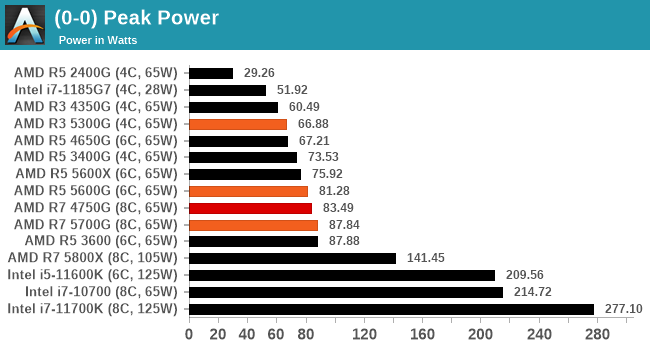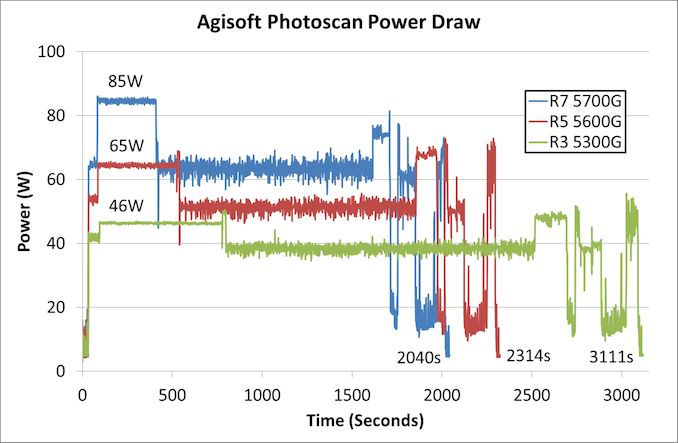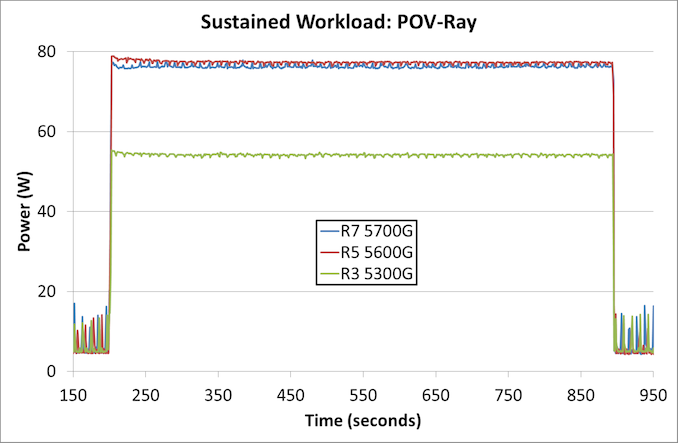The AMD Ryzen 7 5700G, Ryzen 5 5600G, and Ryzen 3 5300G Review
by Dr. Ian Cutress on August 4, 2021 1:45 PM ESTPower Consumption
The nature of reporting processor power consumption has become, in part, a dystopian nightmare. Historically the peak power consumption of a processor, as purchased, is given by its Thermal Design Power (TDP, or PL1). For many markets, such as embedded processors, that value of TDP still signifies the peak power consumption. For the processors we test at AnandTech, either desktop, notebook, or enterprise, this is not always the case.
Modern high-performance processors implement a feature called Turbo. This allows, usually for a limited time, a processor to go beyond its rated frequency. Exactly how far the processor goes depends on a few factors, such as the Turbo Power Limit (PL2), whether the peak frequency is hardcoded, the thermals, and the power delivery. Turbo can sometimes be very aggressive, allowing power values 2.5x above the rated TDP.
AMD and Intel have different definitions for TDP, but are broadly speaking applied the same. The difference comes to turbo modes, turbo limits, turbo budgets, and how the processors manage that power balance. These topics are 10000-12000 word articles in their own right, and we’ve got a few articles worth reading on the topic.
- Why Intel Processors Draw More Power Than Expected: TDP and Turbo Explained
- Talking TDP, Turbo and Overclocking: An Interview with Intel Fellow Guy Therien
- Reaching for Turbo: Aligning Perception with AMD’s Frequency Metrics
- Intel’s TDP Shenanigans Hurts Everyone
In simple terms, processor manufacturers only ever guarantee two values that are tied together - when all cores are running at base frequency, the processor should be running at or below the TDP rating. All turbo modes and power modes above that are not covered by warranty. Intel kind of screwed this up with the Tiger Lake launch in September 2020, by refusing to define a TDP rating for its new processors, instead of going for a range. Obfuscation like this is a frustrating endeavor for press and end-users alike.
However, for our tests in this review, we measure the power consumption of the processor in a variety of different scenarios. These include workflows, real-world image-model construction, and others as appropriate. These tests are done as comparative models. We also note the peak power recorded in any of our tests.
First up is our image-model construction workload, using our Agisoft Photoscan benchmark. This test has a number of different areas that involve single thread, multi-thread, or memory limited algorithms.
For the Ryzen 7 5700G, the most power-hungry part of the test is right at the beginning, where we’re seeing peaks of 85 W. For the 5600G, that first section goes to 65 W, but the peaks actually occur here near the end of the test. The 5300G also has peaks later in the test, but that first section is the lowest, running only at 46 W.
The second test is a sustained rendering workload.
In this instance, the Ryzen 3 5300G is nearer 55 W with a sustained workload over 10 minutes, while the Ryzen 5 and Ryzen 7 sit just below 80 W.
For peak power, we report the highest value observed from any of our benchmark tests.

While all three processors have a TDP rating of 65 W, by default on AMD systems the Package Power Tracking, which is the limiting factor here, is 88 W. The Ryzen 7 is practically at that value, while the Ryzen 5 just goes a smidge over 80 W. The Ryzen 3 on the other hand only matches its TDP in the worst-case scenario.












135 Comments
View All Comments
linuxgeex - Wednesday, August 4, 2021 - link
There's a silly number of errors in the first page of this review. The 5600G does not have "8 cores". Intel didn't "cut" AMD products from the market. Cezanne processors don't use "Zen 3 graphics".Please proof your work, we expect better from Anandtech.
The_Assimilator - Thursday, August 5, 2021 - link
"we expect better from Anandtech"If you've been around since Anand left, you really shouldn't. I don't know who's nominally in charge nowadays but they CBA to perform basic proofreading on most articles.
Machinus - Wednesday, August 4, 2021 - link
When are we going to see 16-20 CUs? Then you could really say you're replacing a GPU.nandnandnand - Wednesday, August 4, 2021 - link
Rembrandt will have RDNA 2 and up to 12 CUs, which should provide acceptable 1080p performance. It will fall short of the Xbox Series S, but not by too much if the graphics clock is higher. It will also have DDR5, better I/O, AV1 decode, etc.Imagine if a Ryzen 7 6700G (OEM) came out in the next 8 months or so.
cigar3tte - Wednesday, August 4, 2021 - link
Will Rembrandt run on AM4 still?nandnandnand - Wednesday, August 4, 2021 - link
DDR5 = AM5. In fact, maybe it will end up being the very first CPUs on AM5.vlad42 - Thursday, August 5, 2021 - link
As I mentioned above, Rembrandt will likely use RDNA1 instead of RDNA2. Drivers for an RDNA1 based APU were just submitted to the Linux kernel a few days ago.nandnandnand - Thursday, August 5, 2021 - link
See above. Rembrandt will use RDNA 2. It might be referred to as "Yellow Carp".https://www.tomshardware.com/news/amd-begins-to-en...
https://www.phoronix.com/scan.php?page=news_item&a...
Fulljack - Wednesday, August 4, 2021 - link
since Van Gogh (Steam Deck) uses 8CU of RDNA2, I think the next generation of APU (Rembrandt) will also features 8CU. Although the moves to DDR5 and possible inclusion of 3D cache (similar to infinity cache) will help performance a lot.This is all are rumour, though.
nandnandnand - Wednesday, August 4, 2021 - link
Rembrandt should have up to 12 CUs. With higher bandwidth from DDR5, perhaps integrated graphics performance will be doubled from the 5800H/5700G. 1080p60 should be achievable in many games, with some settings turned down.I do not expect Rembrandt to have Infinity Cache, 3D V-Cache, L4 cache/HBM, or increased cache whatsoever (Cezanne already doubled from Renoir, and quadrupled the amount each core could access). Any cache improvement would be a pleasant surprise.